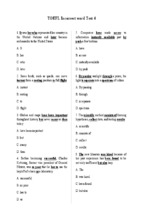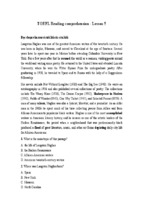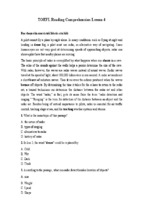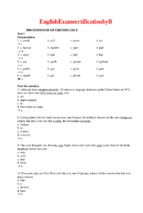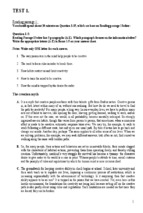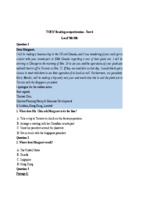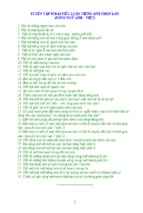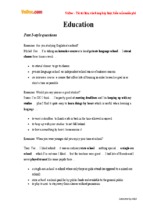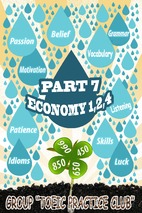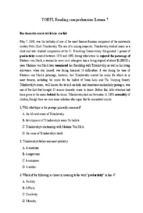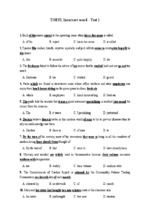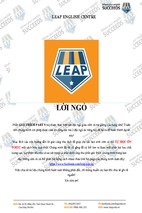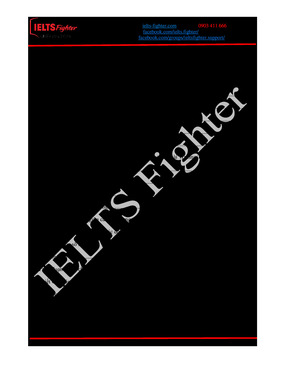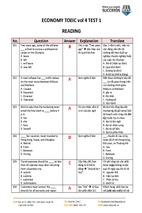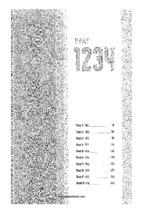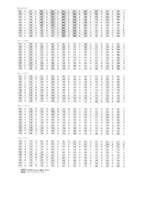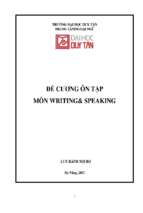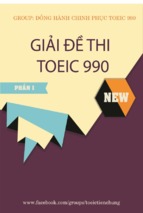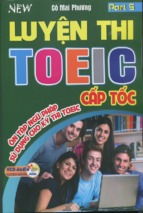TOEFL Reading
Test 1
Question 1-8
With Robert Laurent and William Zorach, direct carving enters into the story of
modern sculpture in the United States. Direct carving ― in which the sculptors
themselves carve stone or wood with mallet and chisel ― must be recognized as
Line something more than just a technique. Implicit in it is an aesthetic principle as well :
(5) that the medium has certain qualities of beauty and expressiveness with which
sculptors must bring their own aesthetic sensibilities into harmony. For example,
sometimes the shape or veining in a piece of stone or wood suggests, perhaps even
dictates, not only the ultimate form, but even the subject matter.
The technique of direct carving was a break with the nineteenth-century tradition in
(10) which the making of a clay model was considered the creative act and the work was
then turned over to studio assistants to be cast in plaster or bronze or carved in marble.
Neoclassical sculptors seldom held a mallet or chisel in their own hands, readily
conceding that the assistants they employed were far better than they were at carving
the finished marble.
(15)
With the turn-of-the-century Crafts movement and the discovery of nontraditional
sources of inspiration, such as wooden African figures and masks, there arose a new
urge for hands-on, personal execution of art and an interaction with the medium. Even
as early as the 1880's and 1890's, nonconformist European artists were attempting
direct carving. By the second decade of the twentieth century, Americans ― Laurent
(20) and Zorach most notably ― had adopted it as their primary means of working.
Born in France, Robert Laurent(1890-1970)was a prodigy who received his
education in the United States. In 1905 he was sent to Paris as an apprentice to an art
dealer, and in the years that followed he witnessed the birth of Cubism, discovered
primitive art, and learned the techniques of woodcarving from a frame maker.
(25)
Back in New York City by 1910, Laurent began carving pieces such as The
Priestess, which reveals his fascination with African, pre-Columbian, and South
Pacific art. Taking a walnut plank, the sculptor carved the expressive, stylized design.
It is one of the earliest examples of direct carving in American sculpture. The plank's
form dictated the rigidly frontal view and the low relief. Even its irregular shape must
(30) have appealed to Laurent as a break with a long-standing tradition that required a
sculptor to work within a perfect rectangle or square.
1. The word “medium”in line 5 could be used to refer to
(A) stone or wood
(B) mallet and chisel
(C) technique
(D) principle
2. What is one of the fundamental principles of direct carving?
(A) A sculptor must work with talented assistants.
(B) The subject of a sculpture should be derived from classical stories.
(C) The material is an important element in a sculpture.
(D) Designing a sculpture is a more creative activity than carving it.
3. The word “dictates” in line 8 is closest in meaning to
(A) reads aloud
(B) determines
(C) includes
(D) records
4. How does direct carving differ from the nineteenth-century tradition
of sculpture?
(A) Sculptors are personally involved in the carving of a piece.
(B) Sculptors find their inspiration in neoclassical sources.
(C) Sculptors have replaced the mallet and chisel with other tools.
(D) Sculptors receive more formal training.
5.The word “witnessed” in line 23 is closest in meaning to
(A) influenced
(B) studied
(C) validated
(D) observed
6. Where did Robert Laurent learn to carve?
(A) New York
(B) Africa
(C) The South Pacific
(D) Paris
7. The phrase “a break with ”in line 30 is closest in meaning to
(A) a destruction of
(B) a departure from
(C) a collapse of
(D) a solution to
8. The piece titled The Priestess has all of the following characteristics EXCEPT
(A) The design is stylized.
(B) It is made of marble.
(C) The carving is not deep.
(D) It depicts the front of a person.
Question 9 - 19
Birds that feed in flocks commonly retire together into roosts. The reasons for
roosting
communally are not always obvious, but there are some likely benefits.
In winter
especially, it is important for birds to keep warm at night and conserve precious food
Line reserves. One way to do this is to find a sheltered roost. Solitary roosters shelter in
(5) dense vegetation or enter a cavity - horned larks dig holes in the ground and
ptarmigan burrow into snow banks - but the effect of sheltering is magnified by
several birds huddling together in the roosts, as wrens, swifts, brown
creepers,
bluebirds, and anis do. Body contact reduces the surface area exposed to the cold air,
so the birds keep each other warm. Two kinglets huddling together were found to
(10) reduce their heat losses by a quarter and three together saved a third of their heat.
The second possible benefit of communal roosts is that they act as “information
centers.” During the day, parties of birds will have spread out to forage over a
very
large area. When they return in the evening some will have fed well, but others may
have found little to eat. Some investigators have observed that when the birds set out
(15) again next morning, those birds that did not feed well on the previous day appear to
follow those that did. The behavior of common and lesser kestrels may illustrate
different feeding behaviors of similar birds with different roosting habits. The common
kestrel hunts vertebrate animals in a small, familiar hunting ground, whereas the very
similar lesser kestrel feeds on insects over a large area. The common kestrel roosts and
(20) hunts alone, but the lesser kestrel roosts and hunts in flocks, possibly so one bird can
learn from others where to find insect swarms.
Finally, there is safety in numbers at communal roosts since there will always be a
few birds awake at any given moment to give the alarm. But this increased protection is
partially counteracted by the fact that mass roosts attract predators and are especially
(25) vulnerable if they are on the ground. Even those in trees can be attacked by birds of
prey. The birds on the edge are at greatest risk since predators find it easier to catch
small birds perching at the margins of the roost.
9. What does the passage mainly discuss?
(A) How birds find and store food
(B) How birds maintain body heat in the winter
(C) Why birds need to establish territory
(D) Why some species of birds nest together
10. The word “conserve ”in line 3 is closest in meaning to
(A) retain
(B) watch
(C) locate
(D) share
11. Ptarmigan keep warm in the winter by
(A) huddling together on the ground with other birds
(B) building nests in trees
(C) burrowing into dense patches of vegetation
(D) digging tunnels into the snow
12. The word “magnified”in line 6 is closest in meaning to
(A) caused
(B) modified
(C) intensified
(D) combined
13. The author mentions kinglets in line 9 as an example of birds that
(A) protect themselves by nesting in holes
(B) nest with other species of birds
(C) nest together for warmth
(D) usually feed and nest in pairs
14. The word “forage”in line 12 is closest in meaning to
(A) fly
(B) assemble
(C) feed
(D) rest
15. Which of the following statements about lesser and common kestrels is true?
(A) The lesser kestrel and the common kestrel have similar diets.
(B) The lesser kestrel feeds sociably but the common kestrel does not.
(C) The common kestrel nests in larger flocks than does the lesser kestrel.
(D) The common kestrel nests in trees; the lesser kestrel nests on the ground.
16. The word “counteracted”in line 24 is closest in meaning to
(A) suggested
(B) negated
(C) measured
(D) shielded
17. Which of the following is NOT mentioned in the passage as an advantage derived
by birds that huddle together while sleeping?
(A) Some members of the flock warn others of impending dangers.
(B) Staying together provides a greater amount of heat for the whole flock
(C) Some birds in the flock function as information centers for others who are
looking for food.
(D) Several members of the flock care for the young.
18. Which of the following is a disadvantage of communal roosts that is mentioned in
the passage?
(A) Diseases easily spread among the birds.
(B) Groups are more attractive to predators than individual birds.
(C) Food supplies are quickly depleted.
(D) Some birds in the group will attack the others.
19. The word “they”in line 25 refers to
(A) a few birds
(B) mass roosts
(C) predators
(D) trees
Question 20 - 30
Before the mid-nineteenth century, people in the United States ate most foods only
in season. Drying, smoking, and salting could preserve meat for a short time, but the
availability of fresh meat, like that of fresh milk, was very limited; there was no way
to
Line prevent spoilage. But in 1810 a French inventor named Nicolas Appert developed the
(5) cooking-and-sealing process of canning. And in the 1850's an American named Gail
Borden developed a means of condensing and preserving milk. Canned goods and
condensed milk became more common during the 1860's, but supplies remained low
because cans had to be made by hand. By 1880, however, inventors had fashioned
stamping and soldering machines that mass-produced cans from tinplate. Suddenly all
(10) kinds of food could be preserved and bought at all times of the year.
Other trends and inventions had also helped make it possible for Americans to vary
their daily diets. Growing urban populations created demand that encouraged fruit and
vegetable farmers to raise more produce. Railroad refrigerator cars enabled growers
and meat packers to ship perishables great distances and to preserve them for longer
(15) periods. Thus, by the 1890's, northern city dwellers could enjoy southern and western
strawberries, grapes, and tomatoes, previously available for a month at
most, for up to
six months of the year. In addition, increased use of iceboxes enabled families to store
perishables. An easy means of producing ice commercially had been
invented in the
1870's, and by 1900 the nation had more than two thousand commercial ice plants,
(20) most of which made home deliveries. The icebox became a fixture in most homes and
remained so until the mechanized refrigerator replaced it in the 1920's and 1930's.
Almost everyone now had a more diversified diet. Some people continued to eat
mainly foods that were heavy in starches or carbohydrates, and not everyone could
afford meat. Nevertheless, many families could take advantage of previously
(25) unavailable fruits, vegetables, and dairy products to achieve more varied fare.
20. What does the passage mainly discuss?
(A) Causes of food spoilage
(B) Commercial production of ice
(C) Inventions that led to changes in the American diet
(D) Population movements in the nineteenth century
21. The phrase “in season” in line 2 refers to
(A) a kind of weather
(B) a particular time of year
(C) an official schedule
(D) a method of flavoring food
22. The word “prevent” in line 4 is closest in meaning to
(A) estimate
(B) avoid
(C) correct
(D) confine
23. During the 1860's, canned food products were
(A) unavailable in rural areas
(B) shipped in refrigerator cars
(C) available in limited quantities
(D) a staple part of the American diet
24. It can be inferred that railroad refrigerator cars came into use
(A) before 1860
(B) before 1890
(C) after 1900
(D) after 1920
25. The word “them ” in line 14 refers to
(A) refrigerator cars
(B) perishables
(C) growers
(D) distances
26. The word “fixture” in line 20 is closest in meaning to
(A) luxury item
(B) substance
(C) commonplace object
(D) mechanical device
27. The author implies that in the 1920's and 1930's home deliveries of ice
(A) decreased in number
(B) were on an irregular schedule
(C) increased in cost
(D) occurred only in the summer
28. The word “Nevertheless” in line 24 is closest in meaning to
(A) therefore
(B) because
(C) occasionally
(D) however
29. Which of the following types of food preservation was NOT mentioned in the
passage?
(A) Drying
(B) Canning
(C) Cold storage
(D) Chemical additives
30. Which of the following statements is supported by the passage?
(A) Tin cans and iceboxes helped to make many foods more widely available.
(B) Commercial ice factories were developed by railroad owners.
(C) Most farmers in the United States raised only fruits and vegetables.
(D) People who lived in cities demanded home delivery of foods.
Question 31 - 38
The ability of falling cats to right themselves in midair and land on their feet has
been a source of wonder for ages. Biologists long regarded it as an example of
adaptation by natural selection, but for physicists it bordered on the miraculous.
Line Newton's laws of motion assume that the total amount of spin of a body cannot change
(5) unless an external torque speeds it up or slows it down. If a cat has no spin when it is
released and experiences no external torque, it ought not to be able to twist around as it
falls.
In the speed of its execution, the righting of a tumbling cat resembles a magician's
trick. The gyrations of the cat in midair are too fast for the human eye to follow, so the
(10) process is obscured. Either the eye must be speeded up, or the cat's fall slowed down
for the phenomenon to be observed. A century ago the former was accomplished by
means of high-speed photography using equipment now available in any pharmacy.
But in the nineteenth century the capture on film of a falling cat constituted a scientific
experiment.
(15)
The experiment was described in a paper presented to the Paris Academy in 1894.
Two sequences of twenty photographs each, one from the side and one from behind,
show a white cat in the act of righting itself. Grainy and quaint though they are, the
photos show that the cat was dropped upside down, with no initial spin, and still landed
on its feet. Careful analysis of the photos reveals the secret ; As the cat rotates the front
(20) of its body clockwise, the rear and tail twist counterclockwise, so that the total spin
remains zero, in perfect accord with Newton's laws. Halfway down, the cat pulls in its
legs before reversing its twist and then extends them again, with the desired end result.
The explanation was that while no body can acquire spin without torque, a flexible one
can readily change its orientation, or phase. Cats know this instinctively, but scientists
(25) could not be sure how it happened until they increased the speed of their perceptions a
thousandfold.
31. What does the passage mainly discuss?
(A) The explanation of an interesting phenomenon
(B) Miracles in modern science
(C) Procedures in scientific investigation
(D) The differences between biology and physics
32. The word “process”in line 10 refers to
(A) the righting of a tumbling cat
(B) the cat's fall slowed down
(C) high-speed photography
(D) a scientific experiment
33. Why are the photographs mentioned in line 16 referred to as an “experiment”?
(A) The photographs were not very clear.
(B) The purpose of the photographs was to explain the process.
(C) The photographer used inferior equipment.
(D) The photographer thought the cat might be injured.
34. Which of the following can be inferred about high-speed photography in
the late 1800's ?
(A) It was a relatively new technology.
(B) The necessary equipment was easy to obtain.
(C) The resulting photographs are difficult to interpret.
(D) It was not fast enough to provide new information.
35. The word “rotates” in line 19 is closest in meaning to
(A) drops
(B) turns
(C) controls
(D) touches
36. According to the passage, a cat is able to right itself in midair because it is
(A) frightened
(B) small
(C) intelligent
(D) flexible
37. The word “readily”in line 24 is closest in meaning to
(A) only
(B) easily
(C) slowly
(D) certainly
38. How did scientists increase “the speed of their perceptions a
thousandfold”(lines 25-26)?
(A) By analyzing photographs
(B) By observing a white cat in a dark room
(C) By dropping a cat from a greater height
(D) By studying Newton's laws of motion
Question 39 - 50
The changing profile of a city in the United States is apparent in the shifting
definitions used by the United States Bureau of the Census. In 1870 the census
officially distinguished the nation's “urban” from its “rural” population for the first
Line time. “Urban population” was defined as persons living in towns of 8,000 inhabitants
(5) or more. But after 1900 it meant persons living in incorporated places having 2,500 or
more inhabitants.
Then, in 1950 the Census Bureau radically changed its definition of“urban”to take
account of the new vagueness of city boundaries. In addition to persons living in
incorporated units of 2,500 or more, the census now included those who lived in
(10) unincorporated units of that size, and also all persons living in the densely settled urban
fringe, including both incorporated and unincorporated areas located around cities of
50,000 inhabitants or more. Each such unit, conceived as an integrated economic and
social unit with a large population nucleus, was named a Standard Metropolitan
Statistical Area (SMSA).
(15)
Each SMSA would contain at least (a) one central city with 50,000 inhabitants or
more or (b) two cities having shared boundaries and constituting, for general economic
and social purposes, a single community with a combined population of at least 50,000,
the smaller of which must have a population of at least 15,000. Such an area included
the county in which the central city is located, and adjacent counties that are found to
(20) be metropolitan in character and economically and socially integrated with the county
of the central city. By 1970, about two-thirds of the population of the United States was
living in these urbanized areas, and of that figure more than half were living outside the
central cities.
While the Census Bureau and the United States government used the term SMSA
(25) (by 1969 there were 233 of them), social scientists were also using new terms to
describe the elusive, vaguely defined areas reaching out from what used to be simple
“towns” and “cities”. A host of terms came into use : “metropolitan
regions,”
“polynucleated population groups,” “conurbations,” “metropolitan clusters,”
“megalopolises,” and so on.
39. What does the passage mainly discuss?
(A) How cities in the United States began and developed
(B) Solutions to overcrowding in cities
(C) The changing definition of an urban area
(D) How the United States Census Bureau conducts a census
40. According to the passage, the population of the United States was
first classified as rural or urban in
(A) 1870
(B) 1900
(C) 1950
(D) 1970
41. The word “distinguished”in line 3 is closest in meaning to
(A) differentiated
(B) removed
(C) honored
(D) protected
42. Prior to 1900, how many inhabitants would a town have to have before being
defined as urban?
(A) 2,500
(B) 8,000
(C) 15,000
(D) 50,000
43. According to the passage, why did the Census Bureau revise the definition
of urban in 1950?
(A) City borders had become less distinct.
(B) Cities had undergone radical social change.
(C) Elected officials could not agree on an acceptable definition.
(D) New businesses had relocated to larger cities.
44. The word “those”in line 9 refers to
(A) boundaries
(B) persons
(C) units
(D) areas
45. The word “constituting” in line 16 is closest in meaning to
(A) located near
(B) determined by
(C) calling for
(D) making up
46. The word “which ” in line 18 refers to a smaller
(A) population
(C) character
(B) city
(D) figure
47. Which of the following is NOT true of an SMSA?
(A) It has a population of at least 50,000
(B) It can include a city's outlying regions.
(C) It can include unincorporated regions.
(D) It consists of at least two cities.
48. By 1970, what proportion of the population in the United States did NOT live in
an SMSA?
(A) 3/4
(B) 2/3
(C) 1/2
(D) 1/3
49. The Census Bureau first used the term “SMSA” in
(A) 1900
(B) 1950
(C) 1969
(D) 1970
50. Where in the passage does the author mention names used by social scientists for
an urban area?
(A) Lines 4-5
(B) Line 7-8 (C) Line 21-23(D) Line 27-29
Test 2
Question 1 - 8
It is commonly believed in the United States that school is where people go to get an
education. Nevertheless, it has been said that today children interrupt their education
to go to school. The distinction between schooling and education implied by this remark
Line is important.
(5)
Education is much more open-ended and all-inclusive than schooling. Education
knows no bounds. It can take place anywhere, whether in the shower or on the job,
whether in a kitchen or on a tractor. It includes both the formal learning that takes place
in schools and the whole universe of informal learning. The agents of education can
range from a revered grandparent to the people debating politics on the radio, from a
(10) child to a distinguished scientist. Whereas schooling has a certain predictability,
education quite often produces surprises. A chance conversation with a stranger may
lead a person to discover how little is known of other religions. People are engaged in
education from infancy on. Education, then, is a very broad, inclusive term. It is a
lifelong process, a process that starts long before the start of school, and one that
(15) should be an integral part of one's entire life.
Schooling, on the other hand, is a specific, formalized process, whose general
pattern varies little from one setting to the next. Throughout a country, children arrive
at school at approximately the same time, take assigned seats, are taught by an adult,
use similar textbooks, do homework, take exams, and so on. The slices of reality that
(20) are to be learned, whether they are the alphabet or an understanding of the workings of
government, have usually been limited by the boundaries of the subject
being taught.
For example, high school students know that they are not likely to find out in their
classes the truth about political problems in their communities or what the newest
filmmakers are experimenting with. There are definite conditions surrounding the
(25) formalized process of schooling.
1. What does the author probably mean by using the expression “children interrupt
their education to go to school” (lines 2-3) ?
(A) Going to several different schools is educationally beneficial.
(B) School vacations interrupt the continuity of the school year.
(C) Summer school makes the school year too long.
(D) All of life is an education.
2. The word “bounds”in line 6 is closest in meaning to
(A) rules
(B) experience
(C) limits
(D) exceptions
3. The word “chance” in line 11 is closest in meaning to
(A) unplanned
(B) unusual
(C) lengthy
(D) lively
4. The word “an integral” in line 15 is closest in meaning to
(A) an equitable
(B) a profitable
(C) a pleasant
(D) an essential
5. The word “they” in line 20 refers to
(A) slices of reality
(B) similar textbooks
(C) boundaries
(D) seats
6. The phrase “For example,” line 22, introduces a sentence that gives
examples of
(A) similar textbooks
(B) the results of schooling
(C) the workings of a government
(D) the boundaries of classroom subjects
7. The passage supports which of the followng conclusions?
(A) Without formal education, people would remain ignorant.
(B) Education systems need to be radically reformed.
(C) Going to school is only part of how people become educated.
(D) Education involves many years of professional training.
8. The passage is organized by
(A) listing and discussing several educational problems
(B) contrasting the meanings of two related words
(C) narrating a story about excellent teachers
(D) giving examples of different kinds of schools
Question 9-17
The hard, rigid plates that form the outermost portion of the Earth are about 100
kilometers thick. These plates include both the Earth's crust and the upper mantle.
The rocks of the crust are composed mostly of minerals with light elements, like
Line aluminum and sodium, while the mantle contains some heavier elements, like iron and
(5) magnesium. Together, the crust and upper mantle that form the surface plates are called
the lithosphere. This rigid layer floats on the denser material of the lower mantle the
way a wooden raft floats on a pond. The plates are supported by a weak, plastic layer
of the lower mantle called the asthenosphere. Also like a raft on a pond, the
lithospheric plates are carried along by slow currents in this more fluid layer beneath
(10) them.
With an understanding of plate tectonics, geologists have put together a new history
for the Earth's surface. About 200 million years ago, the plates at the Earth's surface
formed a “supercontinent” called Pangaea. When this supercontinent started to tear
apart because of plate movement, Pangaea first broke into two large continental masses
(15) with a newly formed sea that grew between the land areas as the depression filled with
water. The southern one ― which included the modern continents of South America,
Africa, Australia, and Antarctica ― is called Gondwanaland. The northern one ― with
North America, Europe, and Asia ― is called Laurasia. North America tore away from
Europe about 180 million years ago, forming the northern Atlantic Ocean.
(20)
Some of the lithospheric plates carry ocean floor and others carry land masses or a
combination of the two types. The movement of the lithospheric plates is
responsible
for earthquakes, volcanoes, and the Earth's largest mountain ranges.
Current
understanding of the interaction between different plates explains why these occur
where they do. For example, the edge of the Pacific Ocean has been called the “Ring
(25) of Fire” because so many volcanic eruptions and earthquakes happen there. Before the
1960's, geologists could not explain why active volcanoes and strong earthquakes
were concentrated in that region. The theory of plate tectonics gave them an answer.
9. With which of the following topics is the passage mainly concerned?
(A) The contributions of the theory of plate tectonics to geological knowledge
(B) The mineral composition of the Earth's crust
(C) The location of the Earth's major plates
(D) The methods used by scientists to measure plate movement
10. According to the passage, the lithospheric plates are given support by the
(A) upper mantle
(B) ocean floor
(C) crust
(D) asthenosphere
11. The author compares the relationship between the lithosphere and the
asthenosphere to which of the following?
(A) Lava flowing from a volcano
(B) A boat floating on the water
(C) A fish swimming in a pond
(D) The erosion of rocks by running water
12. The word“one”in line 16 refers to
(A) movements
(B) masses
(C) sea
(D) depression
13. According to the passage, the northern Atlantic Ocean was formed when
(A) Pangaea was created
(B) plate movement ceased
(C) Gondwanaland collided with Pangaea
(D) parts of Laurasia separated from each other
14. The word “carry” in line 20 could best be replaced by
(A) damage
(B) squeeze
(C) connect
(D) support
15. In line 27, the word“concentrated”is closest in meaning to which of the following?
(A) Allowed
(B) Clustered
(C) Exploded
(D) Strengthened
16. Which of the following can be inferred about the theory of plate tectonics?
(A) It is no longer of great interest to geologists.
(B) It was first proposed in the 1960's.
(C) It fails to explain why earthquakes occur.
(D) It refutes the theory of the existence of a supercontinent.
17. The paragraph following the passage most probably discusses
(A) why certain geological events happen where they do
(B) how geological occurrences have changed over the years
(C) the most unusual geological developments in the Earth's history
(D) the latest innovations in geological measurement
Question18-27
In the United States in the early 1800's, individual state governments had more
effect on the economy than did the federal government. States chartered
manufacturing, banking, mining, and transportation firms and participated in the
Line construction of various internal improvements such as canals, turnpikes, and railroads.
(5) The states encouraged internal improvements in two distinct ways ; first, by actually
establishing state companies to build such improvement ; second, by
providing part of
the capital for mixed public-private companies setting out to make a profit.
In the early nineteenth century, state governments also engaged in a surprisingly
large amount of direct regulatory activity, including extensive licensing and inspection
(10) programs. Licensing targets reflected both similarities in and differences between the
economy of the nineteenth century and that of today : in the nineteenth century, state
regulation through licensing fell especially on peddlers, innkeepers, and retail
merchants of various kinds. The perishable commodities of trade generally came under
state inspection, and such important frontier staples as lumber and gunpowder were
(15) also subject to state control. Finally, state governments experimented with direct labor
and business regulation designed to help the individual laborer or consumer, including
setting maximum limits on hours of work and restrictions on price-fixing by businesses.
Although the states dominated economic activity during this period, the federal
government was not inactive. Its goals were the facilitation of western settlement and
(20) the development of native industries. Toward these ends the federal government
pursued several courses of action. It established a national bank to stabilize banking
activities in the country and, in part, to provide a supply of relatively easy money to the
frontier, where it was greatly needed for settlement. It permitted access to public
western lands on increasingly easy terms, culminating in the Homestead Act of 1862,
(25) by which title to land could be claimed on the basis of residence alone. Finally, it set up
a system of tariffs that was basically protectionist in effect, although maneuvering for
position by various regional interests produced frequent changes in tariff rates
throughout the nineteenth century.
18. What does the passage mainly discuss?
(A) States's rights versus federal rights
(B) The participation of state governments in railroad, canal, and
turnpike construction
(C) The roles of state and federal governments in the economy
of the nineteenth century
(D) Regulatory activity by state governments
19. The word “effect” in line 2 is closest in meaning to
(A) value
(B) argument
(C) influence
(D) restraint
20. All of the following are mentioned in the passage as areas that involved state
governments in the nineteenth century EXCEPT
(A) mining
(B) banking
(C) manufacturing
(D) higher education
21. The word “distinct” in line 5 is closest in meaning to
(A) separate
(B) innovative
(C) alarming
(D) provocative
22. It can be inferred from the first paragraph that in the nineteenth century canals
and railroads were
(A) built with money that came from the federal government
(B) much more expensive to build than they had been previously
(C) built predominantly in the western part of the country
(D) sometimes built in part by state companies
23. The regulatory activities of state governments included all of the following
EXCEPT
(A) licensing of retail merchants
(B) inspecting materials used in turnpike maintenance
(C) imposing limits on price-fixing
(D) control of lumber
24. The word “setting” in line 17 is closest in meaning to
(A) discussing
(B) analyzing
(C) establishing
(D) avoiding
25. The word “ends” in line 20 is closest in meaning to
(A) benefits
(B) decisions
(C) services
(D) goals
26. According to the passage, which of the following is true of the Homestead
Act of 1862 ?
(A) It made it increasingly possible for settlers to obtain land in the West.
(B) It was a law first passed by state governments in the West.
(C) It increased the money supply in the West.
(D) It established tariffs in a number of regions.
27. Which of the following activities was the responsibility of the federal government
in the nineteenth century?
(A) Control of the manufacture of gunpowder
(B) Determining the conditions under which individuals worked
(C) Regulation of the supply of money
(D) Inspection of new homes built on western lands
Question 28-37
Life originated in the early seas less than a billion years after Earth was formed.
Yet another three billion years were to pass before the first plants and animals
appeared
on the continents. Life's transition from the sea to the land was perhaps as much of an
Line evolutionary challenge as was the genesis of life.
(5)
What forms of life were able to make such a drastic change in lifestyle ? The
traditional view of the first terrestrial organisms is based on megafossils ― relatively
large specimens of essentially whole plants and animals. Vascular plants, related to
modern seed plants and ferns, left the first comprehensive megafossil record. Because
of this, it has been commonly assumed that the sequence of terrestrialization reflected
(10) the evolution of modern terrestrial ecosystems. In this view, primitive vascular plants
first colonized the margins of continental waters, followed by animals that fed on the
plants, and lastly by animals that preyed on the plant-eaters. Moreover, the megafossils
suggest that terrestrial life appeared and diversified explosively near the boundary
between the Silurian and the Devonian periods, a little more than 400 million
(15) years ago.
Recently, however, paleontologists have been taking a closer look at the sediments
below this Silurian-Devonian geological boundary. It turns out that some fossils can be
extracted from these sediments by putting the rocks in an acid bath.
The
technique has
uncovered new evidence from sediments that were deposited near the shores of the
(20) ancient oceans ― plant microfossils and microscopic pieces of small animals. In many
instances the specimens are less than one-tenth of a millimeter in diameter. Although
they were entombed in the rocks for hundreds of millions of years, many of the fossils
consist of the organic remains of the organism.
These newly discovered fossils have not only revealed the existence of previously
(25) unknown organisms, but have also pushed back these dates for the invasion of land by
multicellular organisms. Our views about the nature of the early plant and animal
communities are now being revised. And with those revisions come new
speculations
about the first terrestrial life-forms.
28. The word “drastic” in line 5 is closest in meaning to
(A) widespread
(B) radical
(C) progressive
(D) risky
29. According to the theory that the author calls “the traditional view,” what was the
first form of life to appear on land?
(A) Bacteria
(B) Meat-eating animals
(C) Plant-eating animals
(D) Vascular plants
30. According to the passage, what happened about 400 million years ago?
(A) Many terrestrial life-forms died out.
(B) New life-forms on land developed at a rapid rate.
(C) The megafossils were destroyed by floods.
(D) Life began to develop in the ancient seas.
31. The word “extracted” in line 18 is closest in meaning to
(A) located
(B) preserved
(C) removed
(D) studied
32. What can be inferred from the passage about the fossils mentioned in lines 17-20 ?
(A) They have not been helpful in understanding the evolution of terrestrial life.
(B) They were found in approximately the same numbers as vascular plant fossils.
(C) They are older than the megafossils.
(D) They consist of modern life-forms.
33. The word “instances” in line 21 is closest in meaning to
(A) methods
(B) processes
(C) cases
(D) reasons
34. The word “they” in line 22 refers to
(A) rocks
(B) shores
(C) oceans
(D) specimens
35. The word “entombed” in lime 22 is closest in meaning to
(A) crushed
(B) trapped
(C) produced
(D) excavated
36. Which of the following resulted from the discovery of microscopic fossils?
(A) The time estimate for the first appearance of terrestrial life-forms was revised.
(B) Old techniques for analyzing fossils were found to have new uses.
(C) The origins of primitive sea life were explained.
(D) Assumptions about the locations of ancient seas were changed.
37. With which of the following conclusions would the author probably agree?
(A) The evolution of terrestrial life was as complicated as the origin of
life itself.
(B) The discovery of microfossils supports the traditional view of how terrestrial
life evolved.
(C) New species have appeared at the same rate over the course of the last
400 million years.
(D) The technology used by paleontologists is too primitive to make accurate
determinations about ages of fossils.
- Xem thêm -

